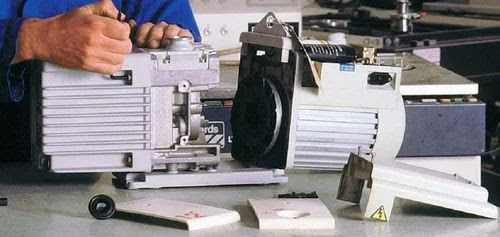question for vacuum pump and vacuum gauge
question for vacuum pump and vacuum gauge
1. I don’t have a micron gauge so I leave the pump on the system for two to four hours, is this enough?
You can’t tell for sure. Without a micron gauge we do not know if the oil in the pump is clean. The oil in a vacuum pump acts as a blotter and absorbs all of the moisture and sediment in the system. As the oil becomes saturated, the efficiency of the pump is drastically reduced.
2. If I put new oil in now and run the pump the same period of time, am I safe?
Oil should be changed after every job and should only be changed when the oil is still hot. As the oil cools, the moisture separates from the oil and clings to the metal of the pump. Therefore, when changing the oil and not checking it with a micron gauge, you’re still guessing as to whether the pump can actually pull the proper vacuum to eliminate the moisture in the system.
3. I pull only from one side of the system using a micron gauge, but at times my gauge will jump up to a higher number. Is this right?
This can happen even if you pull on both sides of the system because there is a metering device to measure the pressure and refrigerant in the system. Air or moisture can be trapped in one side of the system and will eventually let go and therefore a higher reading on the micron gauge will occur. Sometimes moisture can be trapped in the oil of the compressor and when it escapes it will show up in the gauge.
4. I purchased a new micron gauge. How low of a vacuum should I pull?
Some manufacturers have a micron range that they want their system pulled down to, so therefore, JB can only suggest a micron reading. Our suggestion is to pull a system down to 250-300 microns only if you are also pulling a vacuum on the compressor. Going below 250 microns, you will start degassing the oil in the compressor and it will not be the same lubricating oil as it was originally. The oil will only degass and will not suck up into the vacuum pump.
5. It seems to take forever to pull down the system I am working on. Does this mean I have a leak or a lot of moisture in the unit?
Assuming that you are pulling on the high and low side of the system, did you remove the access valve cores? Leaving the cores in creates a big restriction and causes your vaccum to take a longer time to evacuate.
6. I bought a new micron gauge and I wanted to try it out with just my vacuum pump. I attached the gauge directly to the pump and it immediately went down. I then closed my blank off valve on my pump and the gauge went up very rapidly. Is the valve on my pump leaking?
No. The gauge is too close to the pump and it does not have a chance to equalize in pressure. To do this experiment correctly, connect your pump and a micron gauge to a small tank with only copper tubing or JB`s DV-29. Close the blank off valve as you did before and you will see a big difference in the reading.
7. You said with copper tubing, why not charging hoses?
Either copper tubing or metal hoses used in JB`s DV-29 are the only ways you can hold vacuum. Vacuum is critical for leaks, more so than refrigerant. Charging hoses, including environmental hoses, still permeate. Beyond permeation, where the hose ferrule is crimped to the hose, represents a potential leak under vacuum. Quick couplers with gaskets are not a good seal. When you screw down the male flare to the gasket quick coupler, the gasket goes into several contortions and will not seal properly. JB uses O-rings on our quick couplers and as you screw down the male flare you get a metal-to-metal seat and the O-ring lays around the flare to give it a perfect seal.
8. Then this means I cannot pull a vacuum on my system unless I use metal hose or copper tubing?
No. You can pull a vacuum with charging hoses, but when you want to blank off the system to check for leaks, you will need to use copper tubing or metal hoses.
9. I put my gauge connection to the pump when I am pulling a vacuum on a system, is this correct?
Many technicians do this for ease of hook-up, but remember with this set up you are actually reading what the pump is doing and not what the pump is doing to the system. To prove this theory, take a 50 foot coil of 1/4″ OD copper tubing, braze a flare on one end and a tee on the other. Attach a micron gauge to the male flare end, a gauge to the tee end, and a line from the tee to the pump. Turn the pump on and you will notice the side closest to the pump will be a lot lower than the other. Eventually, this will equalize out and give the same reading. This will occur in a system on which you are pulling a vacuum.



